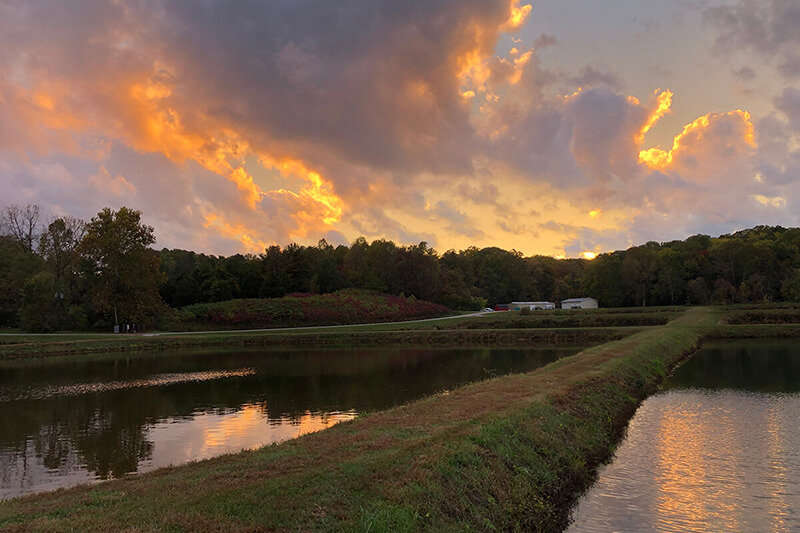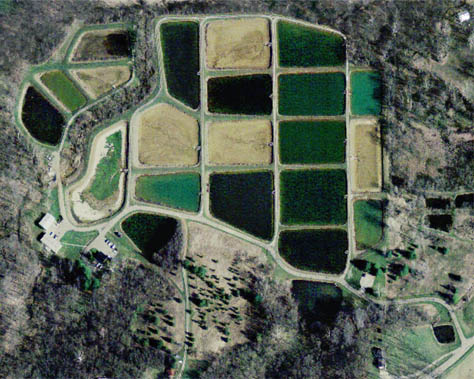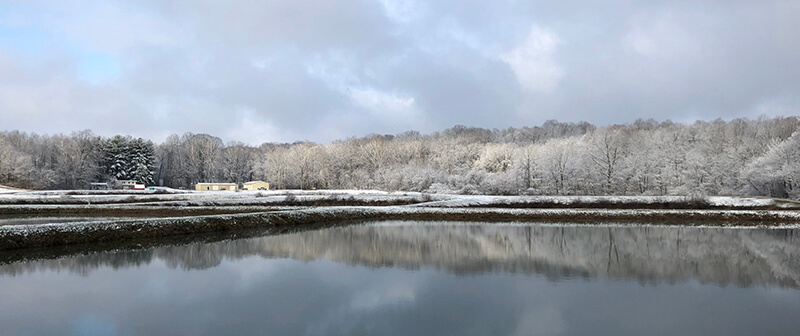Main Content
Article
Cikana State Fish Hatchery

2650 SR 44
Martinsville, IN 46151
765-342-5527
The property is open from dawn to dusk daily for walking, wildlife viewing, etc.
Office Hours: 8 a.m. to 4 p.m., Monday through Friday, closed on state holidays.
- Location
Cikana State Fish Hatchery is located near Martinsville, in Morgan County. The hatchery offices are located at the East Unit off State Road 44, one mile east of Interstate 69/State Road 37. A second parcel, known as the North Unit, is located along I-69/S.R. 37, one mile north of S.R. 44. The property is open to the public during operating hours. Tours can be arranged by contacting the hatchery staff.
- History
By the mid-1960s, the need for expansion of Indiana’s existing hatchery system was apparent due to the rapidly increasing amount of public waters. Construction of numerous reservoirs and impoundments created the need for a centralized, warm-water facility to boost production of species, such as largemouth bass, bluegill, and channel catfish. In 1966, a parcel of land featuring 105 ponds (totaling 29.5 acres) was purchased from Grassyforks Fisheries, a major producer of goldfish. After extensive renovations and the addition of a second parcel of land with 18 additional ponds (totaling 7.5 acres), the preparation of Cikana State Fish Hatchery was completed in 1975.
With a large number of ponds, ample acreage available, and a constant supply of clean well water, Cikana was primed to help biologists meet the demands of Indiana’s growing public waters. Today, Cikana operates as a warm-water/cool-water facility focusing on the production of walleye, sauger, channel catfish, largemouth bass, bluegill, redear sunfish, black crappie, and fathead minnows.

The East Unit
The East Unit was the original parcel of land: 78 acres total with 105 ponds when purchased. Extensive renovations between 1966 and 1975 transformed these shallow goldfish-rearing ponds into 22 ponds totaling 21 acres of surface area. Ranging in size from 0.3 to 1.7 acres, each pond now features a strengthened levee and is sloped to drain into a concrete basin. Ponds drain through a connected drainage system and are supplied by individual fill lines connected to a total of four wells on the property.
The main hatchery offices, a three-bay service building, and Cikana's fish culture building are located on the East Unit. The culture building is supplied water from a 10,000-gallon tank that can be filled with well water or pond water, per each species’ needs.
Also located on the East Unit are the property manager’s residence, District 4 Fisheries Management offices, and the office of the Invasive Species Unit supervisor. Two large wildflower plots, as well as hiking on two trails, or around pond levees, are popular attractions.
The North Unit
The 40-acre North Unit was renovated in 1981 to bolster production at Cikana with an additional 13 ponds totaling 7.4 acres. In 2020, a second renovation combined several ponds, leaving 11 ponds totaling 7.5 acres. Each new pond has increased volume, strengthened levees, and its own concrete harvest structure, and is connected to improved water supply and drainage systems.
Also located on the North Unit are the assistant property manager’s residence, a storage barn, and a three-bay service building.
- Production
Cikana is a warm-water/cool-water hatchery that uses both extensive and intensive culture techniques. Extensive fish culture performed in ponds at Cikana mimics natural rearing but at greater densities, often with supplemental feeding. Intensive culture, carried out in the hatchery building, relies upon controlling environmental factors, such as water flow and dissolved oxygen content, to produce the maximum number of fish in the space available.
Walleye
Walleye production begins in late March with egg collection at Brookville Lake. Personnel from all over the Division of Fish & Wildlife assist in the collection and fertilization of more than 35 million eggs annually. These fertilized eggs are transported to Cikana, where they are treated for diseases and against zebra mussels, then cared for until hatching. Nearly 30 million 5-day-old walleye fry are stocked in reservoirs around the state throughout April each year. Several hatcheries grow these fry at their facilities. Walleye fingerlings are raised in specially fertilized ponds, where plankton quantity and water quality are monitored daily. Plankton, specifically zooplankton, are microscopic creatures that serve as the young walleyes’ only food source until stocking. Additional fertilizer is added throughout pond rearing to maximize plankton production, which increases walleye growth and survival. Each year hatchery staff raise approximately 600,000 walleye fingerlings to be stocked in select reservoirs in late May and early June.
In conjunction with the walleye program, Cikana maintains captive sauger brood stock to allow production of 60,000 sauger fingerlings. Raised similarly to walleye fingerlings, sauger fingerlings are stocked in river and stream systems. Sauger males are also used to help produce 52,000 hybrid walleye fingerlings. Also known as saugeye, these fingerlings are stocked in select waters where walleye populations have not fared well.
Channel Catfish
Channel catfish production begins in early June with the placement of metal milk cans in our two catfish brood ponds. These spawning structures are checked twice per week for two or three weeks until an adequate number of eggs is collected. Hatching occurs after approximately one week, producing up to a half-million catfish fry. These fry are reared in indoor troughs where they can be cleaned up after, treated for parasites, and trained to a dry feed diet. After several weeks, fry are stocked in ponds at Cikana and fed until cold weather reduces their foraging in late autumn. In addition to the dry feed, the young catfish have a variety of zooplankton, insect larvae, and benthic invertebrates available in the ponds to provide a well-rounded, natural diet.
In March of the next year, the 9-month-old fingerlings are harvested, sorted by size, measured and numerated. These 3- to 6-inch fish are then treated for parasites before being spread among several warm-water hatcheries around the state to continue growth until the fall harvest season. At Cikana, these juvenile catfish are raised in ponds also stocked with fathead minnows, which provides them with another option for forage.
Advanced catfish fingerlings are harvested in October with a goal of nearly 12,000 10-inch fish and over 90,000 8-inch fish produced statewide. Most of these 16-month-old fish are stocked in a variety of public lakes, reservoirs, pits, and ponds all over the state. Around 1,000 are held over at Cikana to be used at the DNR State Fair Fishin’ Pond and enjoyed by thousands of fairgoers each August. An additional 5,000 are held a little longer and used for stockings in urban parks through our urban fishing program.
State Fair
Cikana is also the permanent home of the aquatic stars of the Indiana State Fair. For 11 months of each year, all of the various species of fish in the DNR building’s display tanks and pools (except the trout, which are supplied by Curtis Creek Trout Rearing Station) are held in a couple of Cikana’s ponds. In early August, the same fish are collected, sorted, and examined year-after-year, with the best specimens journeying to the fairgrounds to perform their annual duty.
Other Species
Bluegill, redear, and black crappie are raised using extensive methods. Brood stock for each species are sorted by sex, then allowed to spawn naturally after stocking in ponds. Fry hatch from May to July and grow to fingerling size (about 2 inches) by November harvest. These fish, both juveniles and adults, feed primarily on natural forage available in the ponds, with only the bluegill consuming a small amount of dry feed. Brood stock are given fathead minnows while over-wintering to promote healthy egg production before spring spawning.
Cikana holds the state’s largemouth bass brood stock and also raises a pond of younger bass each year to serve as the next generation of brood stock. Excess minnows from catfish fingerling ponds harvested in the fall are stocked in largemouth bass ponds to promote healthy growth and high-quality eggs.
- Volunteer Opportunities
Need a reason to get outside and move? You can volunteer alone or in small groups at this property. Some activities include trash pick-up, basic gardening, painting, and more. Call the property office for details.
- Photos & Video
Walleye Production
Fish Display at the Indiana State Fair

